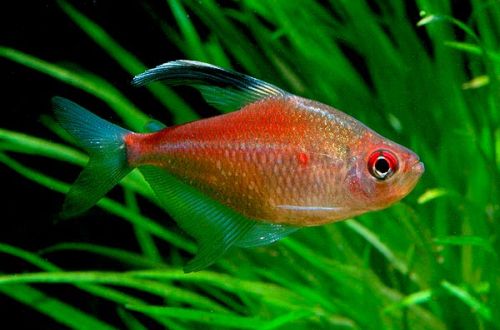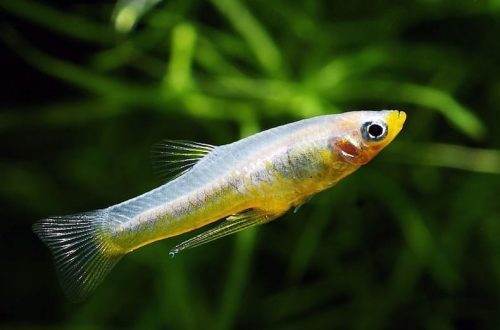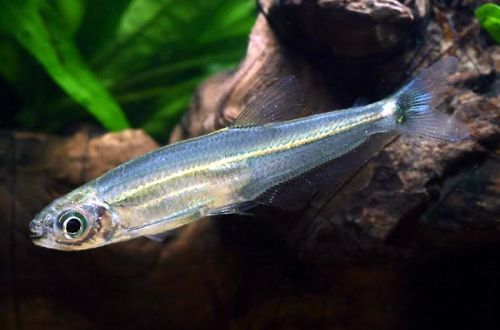
Red Ornatus
Ornatus Longfin, Red Rubostigma or Red Ornatus, scientific name Hyphessobrycon pyrrhonotus, belongs to the Characins family. A popular aquarium fish, however, due to similarities with other related species, it is often supplied under other names. Easy to keep and breed, it is compatible with many freshwater species, making it a good choice for the beginner aquarist.

Contents
Habitat
It comes from South America from the Rio Negro basin (Amazonas, Brazil), the largest left tributary of the Amazon. There are suggestions that the natural distribution area is much wider. Fish inhabit small rivers and streams flowing through dense rainforest. A typical biotope is a shallow stream, the bed of which is littered with various tree structures (roots, branches), with overhanging coastal vegetation and aquatic plants. The bottom is sandy, covered with a layer of fallen leaves. Water acquires a rich brown hue due to the abundance of organic matter.
Brief information:
- The volume of the aquarium – from 60 liters.
- Temperature – 20-28°C
- Value pH — 4.0–7.0
- Water hardness – 1–8 dGH
- Substrate type – any
- Lighting – subdued
- Brackish water – no
- Water movement is weak
- The size of the fish is about 4 cm.
- Feeding – any food of suitable size
- Temperament – peaceful
- Keeping in a group of 8-10 individuals
Description
It is a close relative of Rubostigma and Tetra Sokolof, which determined their external similarity. Adults reach a length of about 4 cm. The color varies from pink to orange-red. Females are lighter in color and look fuller, especially in the spawning state. Males are brighter and have elongated anal and dorsal fins, the latter having a dark tip. There is a noticeable red spot on the body behind the gill cover – a characteristic feature of this group of fish.
Food
Unpretentious, in the home aquarium will accept most popular foods designed for aquarium fish. The diet directly affects the color and general condition of the fish, so it is necessary to use only high-quality products from well-known manufacturers.
Maintenance and care, arrangement of the aquarium
The optimal size of an aquarium for a flock of 8–01 fish starts at 60 liters. Red Rubostigma can adapt to different environments, however, it is desirable to choose a design that resembles its natural habitat. The fish will look more harmonious among thickets of aquatic plants and snags in dim lighting conditions.
A useful addition would be the use of the leaves of some trees placed at the bottom. In the process of decomposition, they release tannins, thereby giving the water a chemical composition similar to that in natural reservoirs, and at the same time it turns brownish. The leaves also promote the growth of colonies of microorganisms such as slipper ciliates, which are a valuable food source for fry.
For the successful keeping of Ornathus longfin, it is important to ensure high water quality, namely: to prevent the accumulation of organic waste, maintain hydrochemical parameters in an acceptable range of values, and regularly carry out a partial replacement of part of the water with fresh water. The ecological balance in the aquarium also largely depends on the operation of the filtration system and other water purification equipment.
Behavior and Compatibility
Peaceful moving fish, get along well with other species of comparable size. It is advisable to purchase a flock of fish in the amount of at least 8-10 individuals. In this case, males, competing with each other for the attention of females, will show their best colors.
Breeding / breeding
In fish that live for generations in an artificial environment, the seasonality of reproduction is disrupted, so they can give birth throughout the year. For example, in a large flock of dozens of individuals, almost every month several fish will come to the spawning state.
Fish reproduce by scattering eggs over the surface of the substrate. In many ways, the process is chaotic, the formation of local masonry does not occur, and fertilized eggs are scattered all over the bottom. Parental instincts are not developed, adult fish do not care about offspring, and on occasion they can even eat their own caviar and fry. To save the brood, it is moved to a separate aquarium.
Fish diseases
Diseases inherent in this particular species of fish were not noted. When kept in suitable conditions (high water quality, balanced diet, non-conflict neighbors, etc.), health problems are not observed. The most common cause of disease is the deterioration of conditions leading to immune suppression, which makes the fish susceptible to infections that are invariably present in the surrounding area. When the first signs of an illness are detected (lethargy, exhaustion, refusal of food, lowered fins, etc.), it is necessary to immediately check the main parameters of the water. Often, the restoration of acceptable living conditions contributes to self-healing, but if the fish is too weak or has received obvious damage, medical treatment will be required. For more information on symptoms and treatments, see the Aquarium Fish Diseases section.





